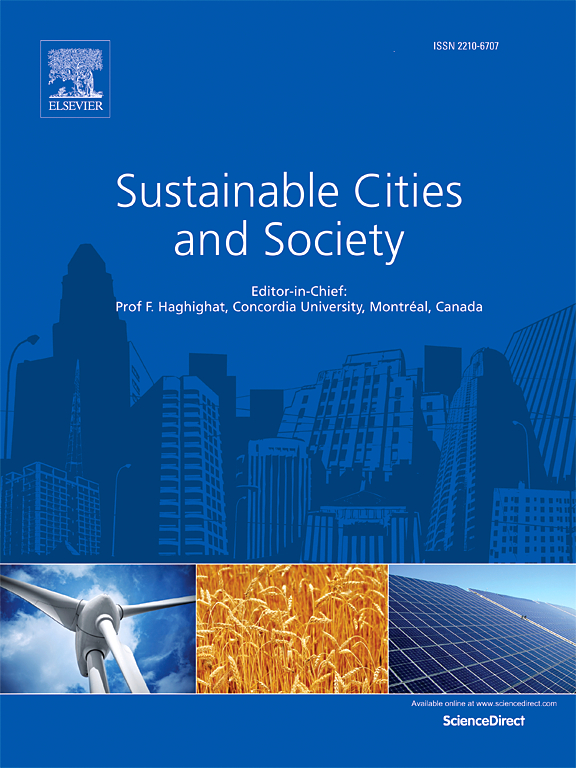全球城市PM2.5的时间格局和社会经济控制
IF 10.5
1区 工程技术
Q1 CONSTRUCTION & BUILDING TECHNOLOGY
引用次数: 0
摘要
随着PM2.5污染对人类健康和可持续发展的挑战越来越大,进一步了解其时间模式对制定有针对性和有效的污染控制策略具有重要意义。然而,近20年来全球各城市PM2.5的时间格局、控制因素和城乡差异有待进一步研究。因此,本文提出识别2000 - 2020年PM2.5的时间格局,并进一步探讨这些时间格局的相关因素。有两个主要的发现总结如下。(1)基于Savitzky-Golay滤波和Mann-Kendall趋势检验的决策树分类方法,将PM2.5的全球时间格局划分为4种典型类型,并通过逐例可视化解释进行验证。四种典型模式分别为渐减型(GDT)、单峰型(SPT)、单谷型(SVT)和渐增型(GIT),分别占16%、49%、2%和16%。全球其他城市在PM2.5的时间模式上没有表现出任何特征(17%)。城市和农村地区在全球PM2.5污染中表现出相似的时间格局。(2)全球城市PM2.5的时空格局受经济发展水平的影响较大。GDT在人类发展非常高的城市中占主导地位,占全球城市的55%。相比之下,SPT和GIT分别占中等人类发展城市的71%和23%,这些城市的污染浓度达到峰值或随着经济增长而增加。此外,还讨论了PM2.5城市污染岛的时间格局、自然因素、对策建议和研究前景。本文旨在更好地了解污染物的来源、扩散和积累过程,为政府和环保部门提出更有效的污染防治措施提供科学依据。本文章由计算机程序翻译,如有差异,请以英文原文为准。
Temporal patterns and socioeconomic controls of PM2.5 across global cities
As PM2.5 pollution poses increasing challenges to human health and sustainable development, further understanding its temporal patterns is significant to develop targeting and effective strategies for pollution control. However, the temporal patterns of PM2.5 for each city worldwide over the past two decades, their controlling factors and difference between urban and rural areas need to be further investigated. Therefore, this paper proposes to identify temporal patterns of PM2.5 from 2000 to 2020 and further explores the related factors for these temporal patterns. There are two major findings summarizing as follows. (1) The global temporal patterns of PM2.5 are grouped into four typical types based on the decision tree classification with Savitzky-Golay filtering and Mann-Kendall trend test, verified through visual interpretation on a case-by-case basis. The four typical patterns are Gradual-Decreasing Type (GDT), Single-Peak Type (SPT), Single-Valley Type (SVT) and Gradual-Increasing Type (GIT), accounting for 16%, 49%, 2% and 16%, respectively. The rest of global cities exhibit none of the features in temporal patterns of PM2.5 (17%). The urban and rural areas show similar temporal patterns in the global PM2.5 pollution. (2) The temporal patterns of PM2.5 in cities around the world are greatly influenced by the level of economic development. The GDT predominates in very high human development cities, comprising 55% of the global cities. In contrast, SPT and GIT account for 71% and 23% of medium human development cities, where pollution concentrations peaked or increases with economic growth. Additionally, nature-based factors for temporal patterns, PM2.5 urban pollution island, strategy proposal and research prospects are discussed. This paper aims to better understand the sources, dispersion, and accumulation processes of pollutants, and provide scientific basis for governments and environmental protection agencies to help propose more effective pollution prevention and control measures.
求助全文
通过发布文献求助,成功后即可免费获取论文全文。
去求助
来源期刊

Sustainable Cities and Society
Social Sciences-Geography, Planning and Development
CiteScore
22.00
自引率
13.70%
发文量
810
审稿时长
27 days
期刊介绍:
Sustainable Cities and Society (SCS) is an international journal that focuses on fundamental and applied research to promote environmentally sustainable and socially resilient cities. The journal welcomes cross-cutting, multi-disciplinary research in various areas, including:
1. Smart cities and resilient environments;
2. Alternative/clean energy sources, energy distribution, distributed energy generation, and energy demand reduction/management;
3. Monitoring and improving air quality in built environment and cities (e.g., healthy built environment and air quality management);
4. Energy efficient, low/zero carbon, and green buildings/communities;
5. Climate change mitigation and adaptation in urban environments;
6. Green infrastructure and BMPs;
7. Environmental Footprint accounting and management;
8. Urban agriculture and forestry;
9. ICT, smart grid and intelligent infrastructure;
10. Urban design/planning, regulations, legislation, certification, economics, and policy;
11. Social aspects, impacts and resiliency of cities;
12. Behavior monitoring, analysis and change within urban communities;
13. Health monitoring and improvement;
14. Nexus issues related to sustainable cities and societies;
15. Smart city governance;
16. Decision Support Systems for trade-off and uncertainty analysis for improved management of cities and society;
17. Big data, machine learning, and artificial intelligence applications and case studies;
18. Critical infrastructure protection, including security, privacy, forensics, and reliability issues of cyber-physical systems.
19. Water footprint reduction and urban water distribution, harvesting, treatment, reuse and management;
20. Waste reduction and recycling;
21. Wastewater collection, treatment and recycling;
22. Smart, clean and healthy transportation systems and infrastructure;
 求助内容:
求助内容: 应助结果提醒方式:
应助结果提醒方式:


